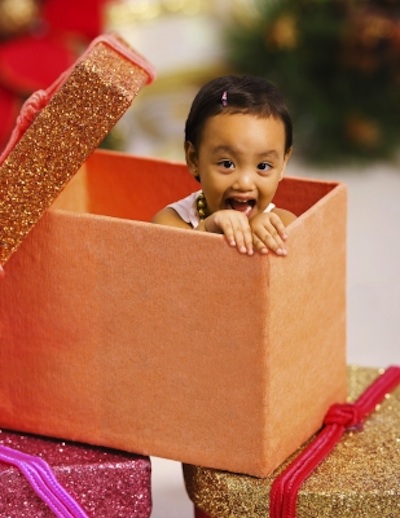5 Ways to Make Your Baby Smile
If your baby just started smiling, you want to see that beautiful, cheeky smile all the time. Sometimes babies smile at new faces, but sometimes they enjoy looking at familiar ones. It can be tough to predict exactly what will make a baby smile, but Mom Trusted has a few tricks up our sleeve. Try these five ways to make your baby smile:
Go for the colors
Babies’ brains are still developing as they take in everything around them in their new, exciting world. Colors are one thing that can excite and catch a baby’s eye. Introduce your baby to colorful toys and items they can hold onto when they start being able to successfully grab objects at around three or four months.
Play with feathers
There’s nothing like a good tickle to get a baby laughing. Try using pretty, colorful feathers, which work great for babies who may not enjoy aggressive tickling the traditional way.
Make funny faces
Your face is your baby’s favorite to look at so your face making goofy faces may be the key to uncontrollable giggles. Try adding peek-a-boo to your silly faces to make your baby smile even more.
Belly raspberries
Make your baby smile by making raspberries on his or her tiny belly. (These are also called zerbits or belly bubbles).
Sing to your baby
Try singing a lullaby, a silly song or even one on the radio to your little one. People of all ages love music and, because music is still a new phenomenon for your child, it might be just the trick you need to make your baby smile. Over time, you’ll start to experiment and find out which songs make him or her smile most and even establish favorite types of music.
Sources:
-“9 Ways to Make Your Baby Laugh” parenting.com: http://www.parenting.com/gallery/9-ways-to-make-your-baby-laugh?pnid=108127
-“5 Ways to Make Your Baby Laugh” Yahoo! Voices: http://voices.yahoo.com/5-fun-ways-baby-laugh-4090891.html
-“7 Ways to Make a Baby Laugh” The Stir: http://thestir.cafemom.com/baby/135281/7_ways_to_make_a
-Photo courtesy of koratmember/freedigitalphotos.net
5 Everyday Objects that Your Baby Will Love to Play With
Sometimes we get so caught up with the cool, new technological baby toys that we forget how much fun they can have with simple, everyday objects. Babies’ curiosity makes simple items lying around the house new adventures. Here are a few to explore with your little one:
Scarves
That pile of scarves sitting in your closet is more than just a bunch of accessories. It’s a great way to make your little one smile. Not only do babies love the silky texture of scarves, but the colorful, bright patterns are sure to catch their eye. Try throwing them around so your baby can watch them twirl around in the air.
Pots and Pans
Just like in the movies, babies love the sound of banging on some pots and pans. Grab a spoon or spatula, some pots or pans and let your little one rock out. OK, so we know the noise can be enough to cause a migraine, so just make sure that you set aside a short time period and stick to it.
Plastic Cups
Safe and simple- babies love stacking plastic cups. Grab a variety of sizes and colors and set them out in front of your little one. The best part? They make for a fast cleanup!
Tupperware
Grab some Tupperware with lids and show your baby how to snap them on. They’ll have a blast matching up the right ones.
Cardboard Boxes
Grab some big cardboard boxes and make a tunnel for your baby to crawl around in. Let them hide under them and cruise through them.
Sources:
-“11 Fun Activities for When Winter Weather Traps You Indoors.” Parents.com
-“5 Unexpected Household Items that Babies Love to Play With.” Yahoo Shine
-Photo courtesy of Stuart Miles/freedigitalphotos.net
Baby Development: What to Look for in Babies 4-7 Months
When your baby hits four months, they’ll begin to go through all sorts of physical and mental growth. From new movements to name recognition, you’ll be amazed at the baby development that your little one goes through in a few short months. MomTrusted has summarized a few exciting milestones to keep an eye out for:
Physical developments
Babies will develop remarkably in physical ways during this stage of growth. Some typical physical developments include:
-The ability to roll right to left
-Some may even develop the ability to roll over to their stomachs
-Color vision
-Clearer vision in general
-Sitting with support and possible on his or her own
-The ability to put support on his or her legs
-Reaching
-Grabbing and transferring with alternating hands
-Raking, or pulling items closer
Mental developments
In addition to going through some big physical changes during these three months, babies will also have tons of new information shaping their minds. Here are some of the cognitive developments that you can expect:
-Spotting covered, “hidden” objects
-Starting to understand and respond to words like “no” and his or her name
-Can keep an eye on moving objects
-Beginning to recognize emotion in voices
-Responding to sounds with his or her own baby noises
Social, language and emotional developments
Finally, between four and seven months, babies will begin to grow socially and emotionally, starting with very small, but powerful signs including:
-Babies’ language skills will increase through babbling consonants.
-He or she will begin to interact with you or others through the form of play.
-Babies start to see, recognize and enjoy their own reflections.
-Not only will babies begin to recognize emotion through voice, but they’ll respond to others’ emotions, often by imitating them.
Sources:
-“Growth and Development Milestones: 4-7 months” parents.com
-“Infant Development: Milestones 4 to 6 Months” Mayo Clinic
-Photo courtesy of magerymajestic/freedigitalphotos.net
10 Ways to Increase Brain Development in Babies
Baby brains develop at a rapid rate. Infants’ neurological wiring holds a world of opportunities. Key development begins at an incredibly early age and stimulating your child’s mind could end up boosting their brainpower and shaping his or her intelligence for years to come. Here are 10 ways to help grow your baby’s intellect:
1. Grow a healthy brain before your baby’s born.
Staying as healthy as possible during pregnancy will give your baby-to-be the best shot at a healthy mind. Maintain a well-balanced diet, exercise, get plenty of sleep and schedule regular doctor appointments. Avoid medications that are known to harm fetal development because often, the brain is the first body part harmed.
2. Pay attention to your little one.
Children have a much higher chance of learning when their curiosity and observations are rewarded. Follow their gaze and comment on what they’re looking at, respond to pointing and describe what the two of you are checking out.
3. Converse with your baby.
Talk to your baby, even if he or she isn’t talking back just yet. Respond to baby talk and describe whatever you’re doing, whether it’s talking about making dinner or changing a diaper. This is how babies learn vocabulary and basic sentence structure.
4. Read to your little one.
Sparking an early interest in books and literature is essential to teaching language. Pick out books with large, colorful illustrations and simple story lines.
5. If your toddler is old enough to play, he or she is old enough to help clean up.
Enforcing cleanup early on introduces important concepts like responsibility and the idea of consequence. But remember, your toddler doesn’t know that cleaning up is a chore yet so make it fun! Sing a cleanup song while you work. Toddlers are eager to help and want to please so make a game out of cleaning up and always remember to thank your little helper.
6. Don’t shy away from a mess.
Scooping mud, splashing water and digging in sand is how little ones explore basic physics. Even though these messy ideas may seem like your worst nightmare, they’re essential for spiking your child’s curiosity and learning. Avoid disaster by making messy play extra structured and keep it outside. Then, when it’s cleanup time, head to the bathtub where your toddler can explore even more textures like slimy soap and a squishy sponge.
7. Allow for crawl space.
Many parents have a hard time letting their newly crawling babies run loose, but this is an important part of their development. Set up a safe, baby-proofed area, free of little objects and blocked off from stairs and sharp corners. Then let your baby run (or crawl) wild. This is how they can investigate the world around them and start to familiarize themselves with day-to-day objects.
8. Sing songs.
Songs are a fun way to learn. Children’s songs teach everything from the alphabet to animals to shapes and colors. They’re also a great way to pass times that may otherwise be boring for a little one. So next time you’re stuck in traffic, bust out your new secret weapon: the Itsy Bitsy Spider.
9. Use every opportunity to learn.
Sometimes parents forget that necessities, like meals or bath time, can be great learning opportunities to explore daily activities. So when you sit down to feed your baby, describe what he or she is eating. Is it fruit, a vegetable or something else? What’s it called? What color is it? Babies will begin to develop favorite tastes and learn to request them by name.
10. Remain positive whenever possible.
No matter how crabby, sleep-deprived and frustrated you get, try your hardest to remain positive. State rules clearly and, by all means, punish if you need to, but always try to reward good behavior. Often times, rewarding the good stuff will save you from having to punish the bad stuff later on.
Sources:
-“20 Ways to Boost Your Baby’s Brain Power.” Scholastic.
-Photo courtesy of Stuart Miles/freedigitalphotos.net
Diaper Bag Checklist
With closets full of diapers, bottles stuffed in your cupboards and toys cluttering your countertops, it’s tough to know exactly what you should have in your diaper bag. You hear phrases about how moms always need to be prepared, but how can you possibly stuff all of that gear into one little (ok, maybe it’s closer to the size of a minivan than you’d like to admit) bag? Here’s a simple checklist to help you organize and prioritize what goes into your diaper bag:
Essentials
The essentials are items that you probably want to have on you at all times, regardless of where you’re going and for how long.
-Diapers (always at least one more than you think you need)
-Wipes (Tip: Save by buying in bulk and sticking them in ziplock bags “travel” bags)
-Plastic bags
-A changing pad
-Bottles and formula
-Snacks (toddlers)
-Sippy cup (toddlers)
-Backup outfit
-Blanket
-Sunscreen
-Pacifier (maybe throw in an extra one since little nooks tend to go missing often)
-Emergency info (better yet, store important information, like doctor’s phone numbers, in your cell phone)
-Favorite toy
-Diaper rash cream
-Bib
Extras
If you have extra space (haha) or plan on being away for a full day or more, consider taking a few more items.
-Extra clothing (and really extra of everything in the essential list)
-Pain relievers
-Comfort toy for your little one to nap with
-Hat if you’re going to be out in the sun
-Hat, mittens and other winter gear if it’s chilly out
-Nail clippers
-Camera
-First-aid kit
Sources:
-“Checklist: What to Put in Your Diaper Bag.” Baby Center
-“What to Keep in Your Baby Diaper Bag.” Parents.com
-“Diaper Bag Essentials.” Mom Advice
-Photo courtesy of digitalart/freedigitalphotos.net
New Study Shows Pacifiers May Stunt Emotional Growth in Boys
Researchers at the University of Wisconsin, Madison found that pacifiers might stunt emotional development, but only in boys. Psychologists at Wisconsin led three experiments connected low emotional maturity to heavy pacifier use as a child.
Psychologists believe the nookies may make it difficult to imitate adult’s facial expressions, a skill that children are perfecting at the binky age. The theory held true for both the six and seven-year-olds and college-aged males that the researchers studied.
The six and seven-year-olds were measured by the amount they mimicked expressions on a video and college males took perspective taking tests. Both experiments were meant to mimic empathy. And in both cases, those who reported heavy pacifier use as children scored lower.
Girls, however, showed no direct correlations between emotional maturity and pacifier use as a child. It may be due to the fact that girls tend to develop earlier, but the reason remains a mystery.
This problem only occurs when facial expressions are being utilized. During times like nap and bedtimes, children are sleeping so expression mimicking is not happening. So even though it may be wise to wean boys off of binkies, this doesn’t mean that parents of baby boys should ditch pacifiers completely.
Sources:
-University of Wisconsin, Madison news releases. 9/18/12.
-Photo courtesy of Carlos Porto/freedigitalphotos.net
Sign Language for Babies
Recently, more and more parents have been teaching their little ones sign language, many before they can even speak. The idea is that babies have the cognitive ability to comprehend language, but lack the physical ability to make the sounds. They can, however, learn sign language because the ability to make hand motions comes before the ability to easily form words.
Many experts even believe the benefits of learning sign language go farther than communication. Some have found that use of signing as a baby leads to confidence and higher self-esteem later in life. Signing also rewards eye contact, an important component of socializing that they’ll master in their later years.
Take the time for a short class, research online or pick up a book on simple sign language. Then start signing to your baby when you speak to him or her. As early or six or seven months, little ones can start using those signs to communicate with you.
Manners
“Please” and “thank you” are easy signs to learn, but they’ll help instill manners from the very beginning, making them a habit and giving you the most polite baby around!
Food
Teach your baby his or her favorite foods. Signs for “milk” “peas” and “applesauce” could save you a spit up mouthful of mushed up carrots. Plus, the simple signs for “food” and “water” help your baby tell you when he or she is hungry or thirsty.
Useful words
Signs for “more” and “done” can be more useful than imaginable. Babies often throw tantrums to show frustration and what’s more frustrating than being unable to communicate? Save yourself a scene by teaching your little one how to ask for more or tell you they’re finished.
Sources:
-“Baby sign language: top ten starter signs.” Baby Sign Language
-“Teaching your baby sign language can benefit both of you.” Psych Central
-Photo courtesy of photostock/freedigitalphotos.net



















